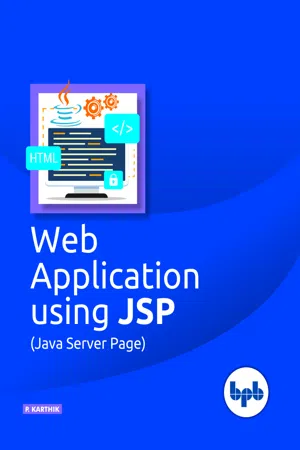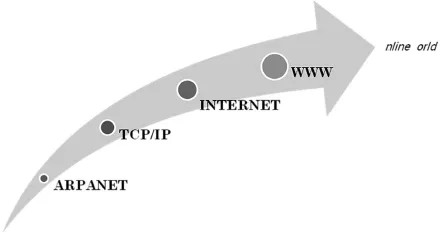
Web Applications using JSP (Java Server Page)
Develop a fully functional web application
- English
- ePUB (mobile friendly)
- Available on iOS & Android
Web Applications using JSP (Java Server Page)
Develop a fully functional web application
About this book
Step by Step guide to develop a Java based web and enterprise application. Key Features
- Correct sequence of the chapters that help the learners to become expertise
- One stop solution for the Java based web application development
- In-depth explanation of topics
- More number of programs are given to understanding the topic
- Developing fully functional application is the primary objective of this, instead of teaching merely topics
- New areas such as Apache POI, Hibernate
- Dedicated chapter for MVC design pattern
Description
Web Application using JSP is a text book and reference for the people who wish to learn and develop a Java based web and enterprise application. It covers all the major topics in JSP. By providing more examples and programs, the learner can develop a fully-functional web application. All the programs are developed and tested with major IDE. First it takes the learner into the world of web application development through the introductory chapter. Later on the JSP is introduced to the learner to make the server-side scripting easy and elegant. Two chapters have been dedicated entirely for database handling through JSP using JDBC and Hibernate. MVC is given to let the learner to integrate features of Servlets and JSP. Producing the HTML page is not the only way for outputting the results of the web application, so two chapters are allotted to teach the learners to output the results of the web application in various forms such PDF, WORD, EXCEL. What Will You Learn
- Fundamentals of Web Application and Java Server Page
- Developing and Executing JSP Program
- Scripting Elements and Implicit Objects
- JSP Document and Action Elements, JSP with Hibernate, Database Access in JSP
- Exception Handling and Expression Language
- Session Management, Custom Tags and Filters
- JSTL (JSP Standard Tag Library)
- MVC based Web Application
- Apache POI, Generating PDF Document
Who This Book Is For
Graduate, Post graduate, Academicians, Educationists, Professionals. Table of Contents
1. Fundamentals of Web Application
2. Fundamentals of Java Server Page
3. Developing and Executing JSP Program
4. Scripting Elements
5. Implicit Objects
6. JSP Document and Action Elements
7. Exception Handling and Expression Language
8. Session Management
9. Custom Tags and Filters
10. JSTL (JSP Standard Tag Library)
11. Database Access in JSP
12. MVC based Web Application
13. Apache POI
14. Generating PDF Document
15. JSP with Hibernate About the Author
P. Karthik has completed MSc Computer Science in the year 2010 and BEd in 2011. Qualified SET during the academic year 2012. Completed MPhil CS in the year 2015. Has completed two diplomas in Animation and Computer Hardware Servicing in TNOU and one PG diploma in Information Security from IGNOU. Working as assistant professor for 5+ years in the UG Department of Computer Science Sacred Heart College – Tirupattur, Tamil Nadu which has received 95th ranking by NIRF in 2017. Have been teaching Java technology for UG and PG students of computer science and software technology since 2012. Guided around 50 students in Java based projects. Presented paper in National and International Journal and conferences and attended many workshops. Specializations are Software Engineering, Java Technology (from core Java to J2EE), Android and Computer Networks.
Frequently asked questions
- Essential is ideal for learners and professionals who enjoy exploring a wide range of subjects. Access the Essential Library with 800,000+ trusted titles and best-sellers across business, personal growth, and the humanities. Includes unlimited reading time and Standard Read Aloud voice.
- Complete: Perfect for advanced learners and researchers needing full, unrestricted access. Unlock 1.4M+ books across hundreds of subjects, including academic and specialized titles. The Complete Plan also includes advanced features like Premium Read Aloud and Research Assistant.
Please note we cannot support devices running on iOS 13 and Android 7 or earlier. Learn more about using the app.
Information
Chapter 1
Fundamentals of Web Application
- To aware about the origin of the Network and Internet.
- To learn about the web infrastructure and communication.
- To differentiate among static and dynamic
- To understand the Client-server Architecture.
- To know the various technologies that make up the website.
- To learn about the directory structure of a website.
- To know how to host a website.
1.1 History of Network and Internet
- Official or Corporate Websites - college and school, organizational websites.
- Web Applications - Online exam application site for SSC, UPSC.
- Enterprise Applications -Banking Applications.
- Social Network sites - Facebook, Twitter.
- E-Commerce sites - Flip kart and Amazon.
- E-Learning platform -Moodle platforms and others.
- Cloud Services - Software services such as GOOGLE apps
- Others - Blog, Government sites or E-governance sites, Community site, News and Religious sites
- University of California, Los Angeles (UCLA)
- Stanford Research Institute (SRI)
- University of Utah
- University of California, Santa Barbara
- WEB SERVERThe CERN httpd or W3C httpd is the world's first Web Server software. Invented in the year 1990.
- WEB BROWSERThe World's first Web Browser software is World Wide Web or Nexus. Invente in the year 1990.

Internet And Www
1.2 Web Infrastructure and Web Communication
Network Architecture
Client-Server Architecture

Table of contents
- Cover
- Web Application Using JSP
- Copyright
- Preface
- Acknowledgement
- Table of Contents
- Chapter 1 : Fundamentals of Web Application
- Chapter 2 : Fundamentals of Java Server Page
- Chapter 3 : Developing and Executing JSP Program
- Chapter 4 : Scripting Elements
- Chapter 5 : Implicit Objects
- Chapter 6 : JSP Document and Action Elements
- Chapter 7 : Exception Handling and Expression Language
- Chapter 8 : Session Management
- Chapter 9 : Custom Tags and Filters
- Chapter 10 : JSTL (JSP Standard Tag Library)
- Chapter 11 : Database Access in JSP
- Chapter 12 : MVC based Web Application
- Chapter 13 : Apache POI
- Chapter 14 : Generating PDF Document
- Chapter 15 : JSP with Hibernate